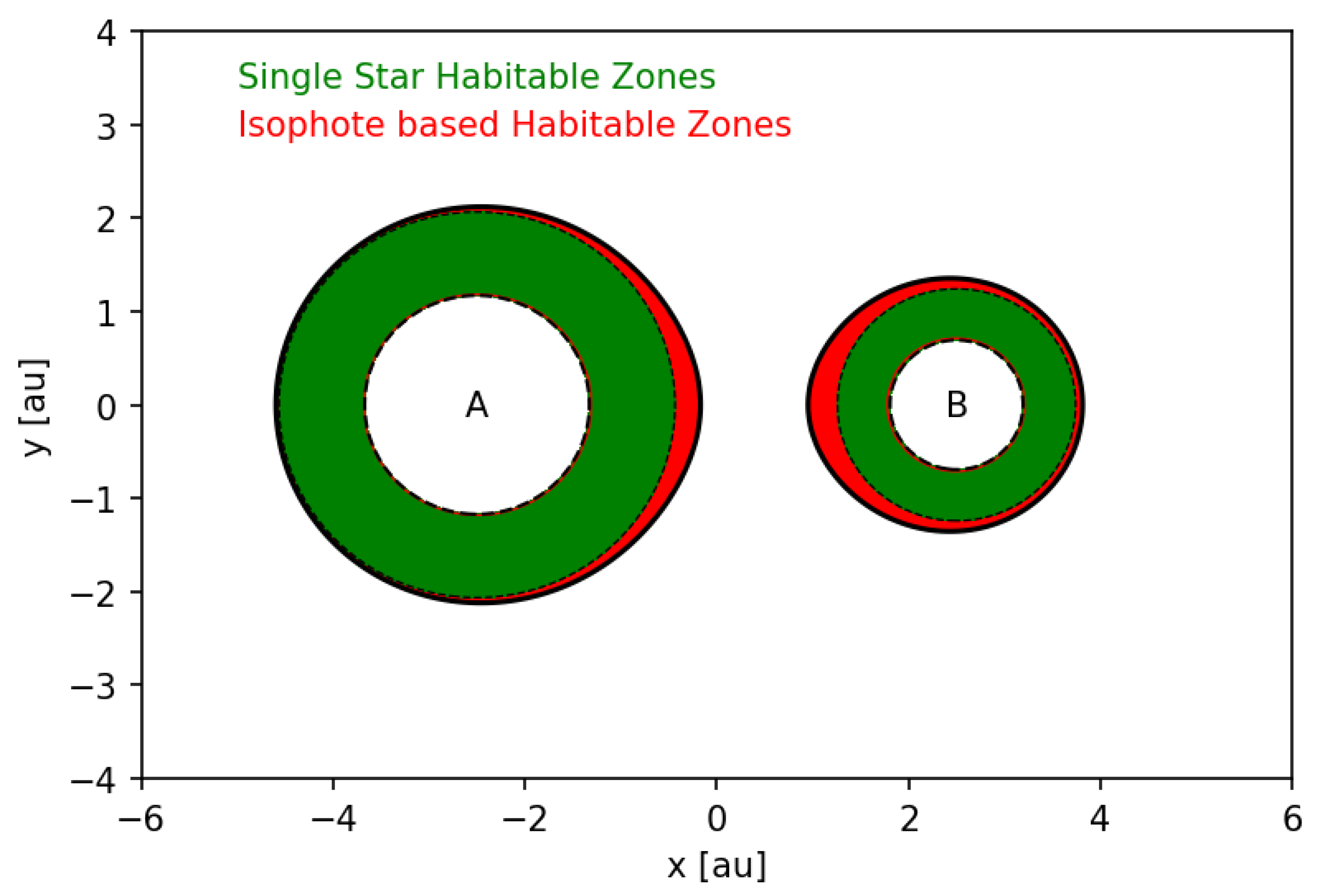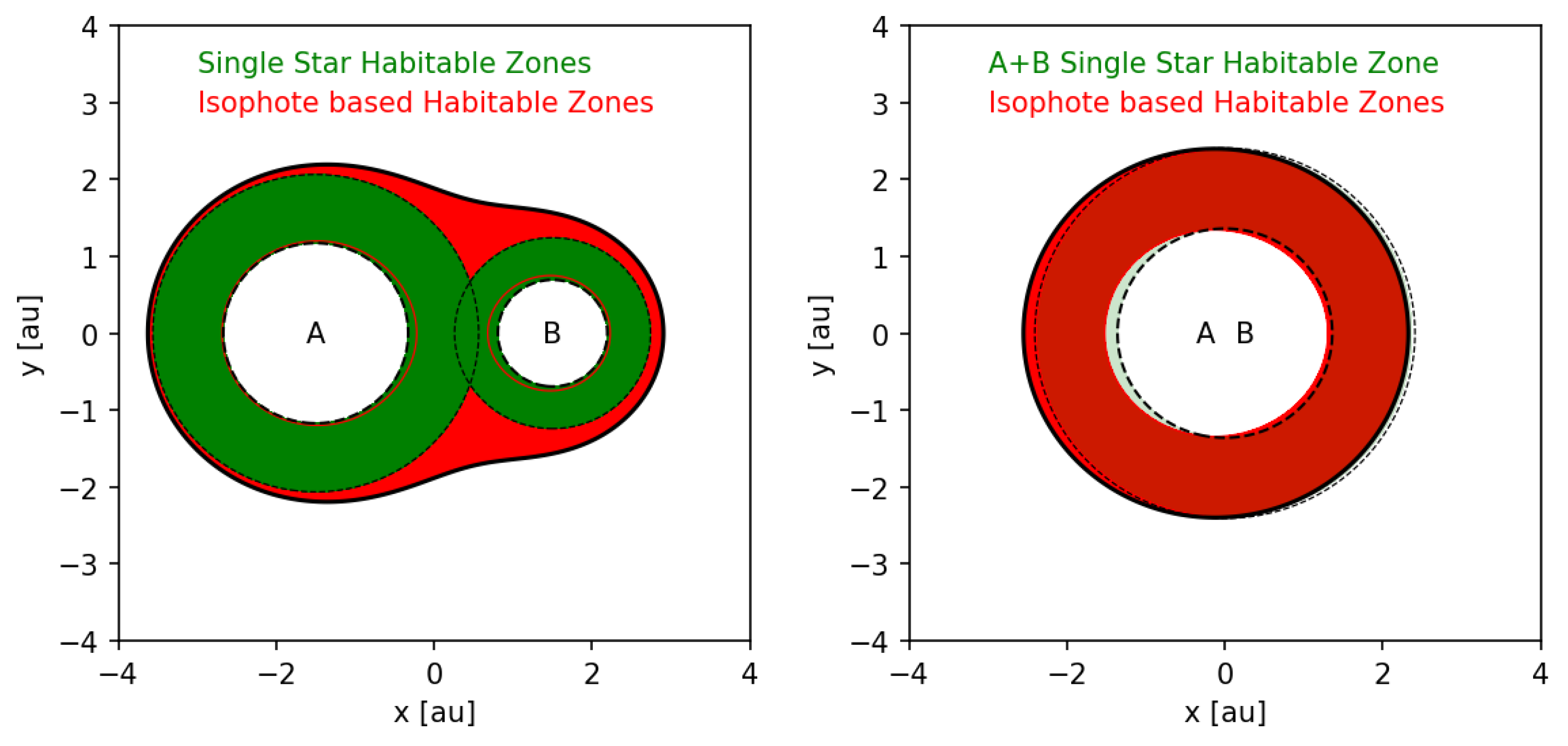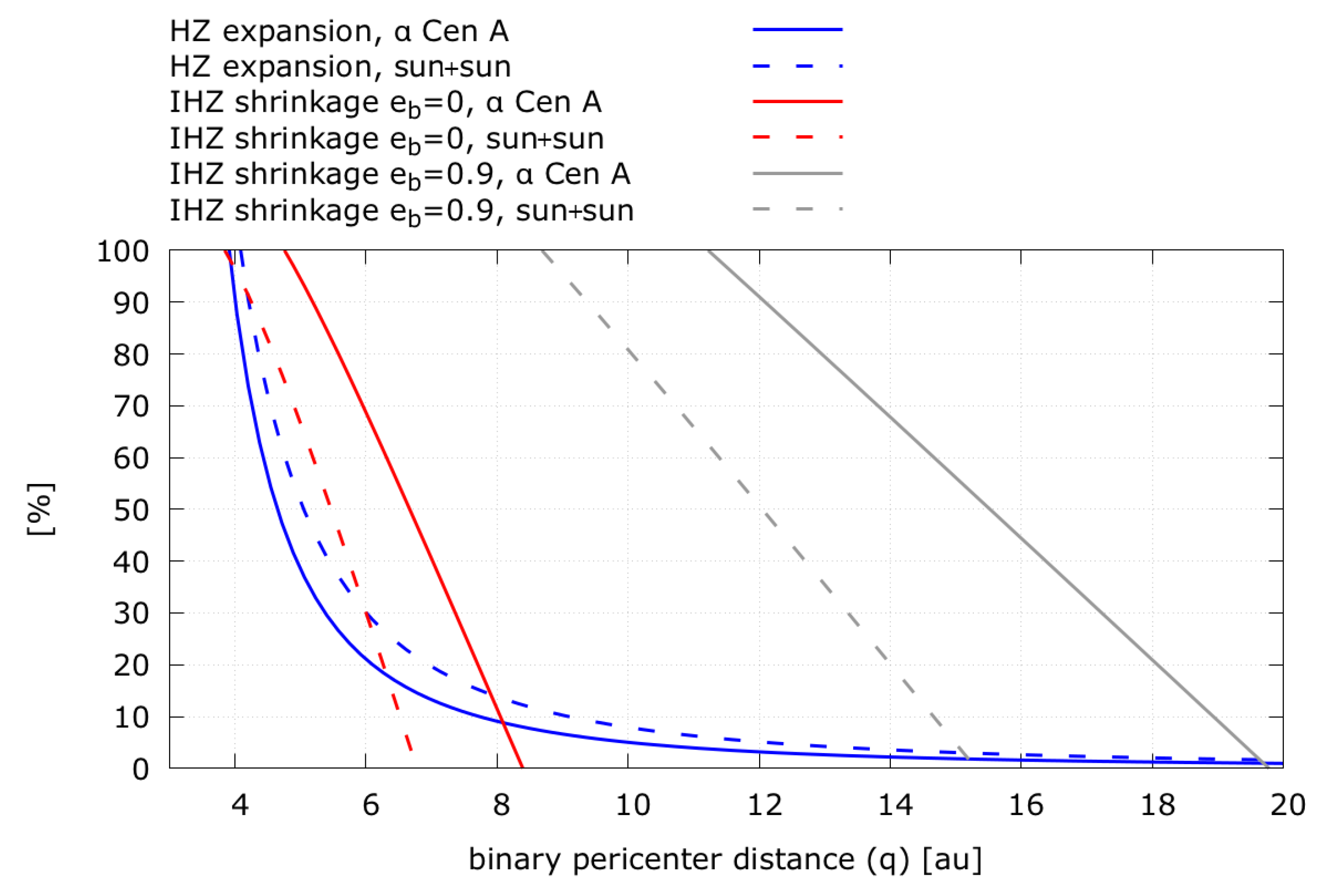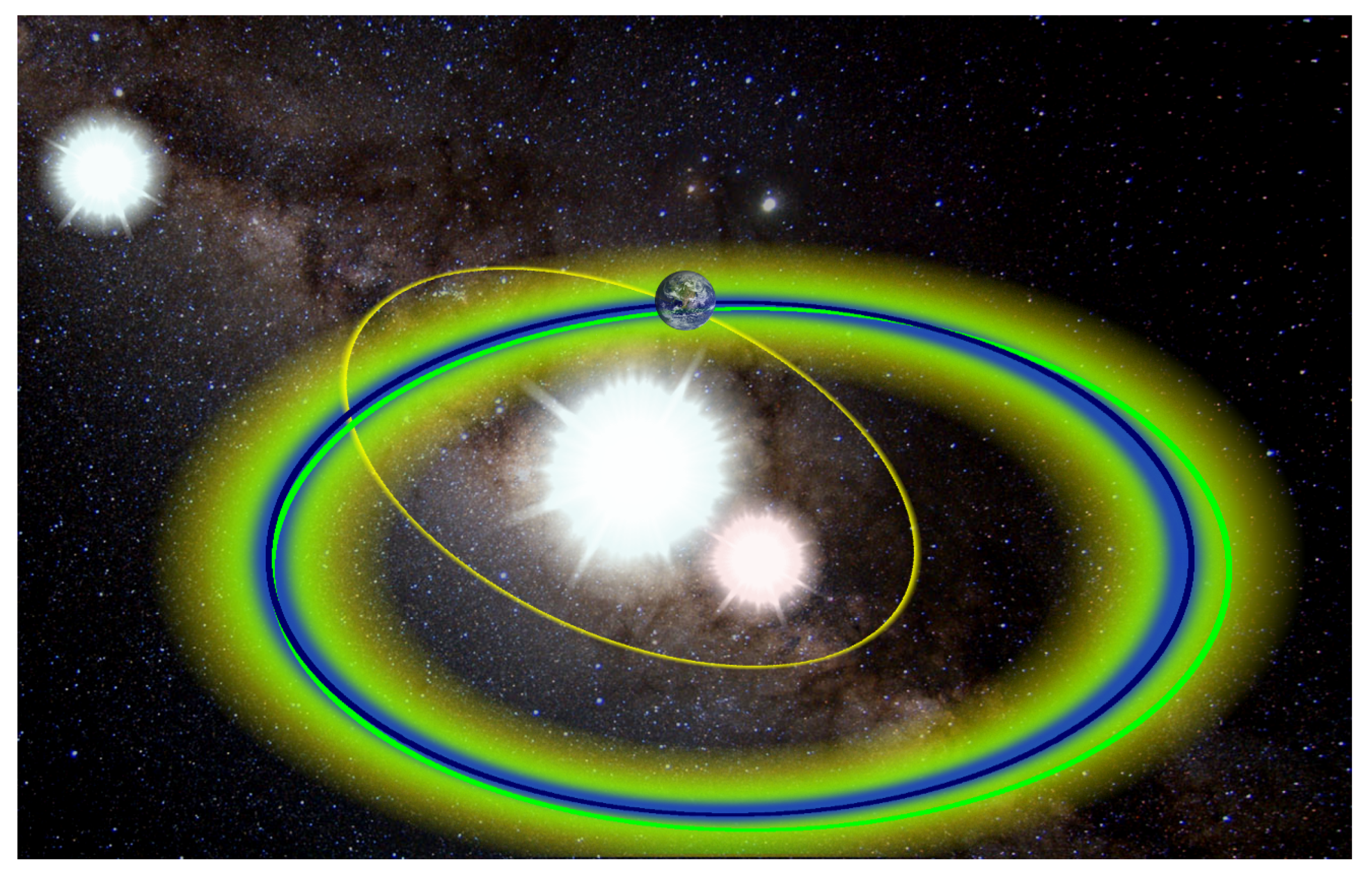Habitable Zones in Binary Star Systems: A Zoology
Abstract
1. Introduction
- single star habitable zones
- isophote-based habitable zones
- radiative habitable zones
- dynamically informed habitable zones
- self consistent habitable zones
2. Single Star Habitable Zones
3. The Trouble with Two Stars
Isophote Based Habitable Zones
4. Radiative Habitable Zones
5. Dynamically Informed Habitable Zones
5.1. Circumstellar Habitable Zones
5.2. Circumbinary Habitable Zones
6. Self-Consistent Models
7. Comparing Habitable Zones
8. Summary and Conclusions
9. Materials and Methods
Author Contributions
Funding
Acknowledgments
Conflicts of Interest
Abbreviations
| AHZ | Averaged Habitable Zone |
| HZ | Habitable Zone |
| IHZ | Isophote-based Habitable Zone |
| PHZ | Permanently Habitable Zone |
| RHZ | Radiative Habitable Zone |
| SSHZ | Single Star Habitable Zone |
| a | distance between the planet and star A |
| spectrally weighted insolation of star A | |
| orbital semi-major axis of binary star | |
| orbital semi-major axis of the planet | |
| b | distance between the planet and star B |
| spectrally weighted insolation of star B | |
| c | distance of circumbinary planet to the center of reference |
| d | distance between the two stars |
| semi-distance between the two stars | |
| orbital eccentricity of the binary star | |
| orbital eccentricity of the planet | |
| forced orbital eccentricity of the planet | |
| true anomaly of the planet | |
| angle between the vectors connecting the two stars and the planet | |
| stellar mass ratio | |
| L | luminosity |
| m | mass |
| pericenter distance of the binary | |
| pericenter distance of the planet | |
| apocenter distance of the binary star | |
| apocenter distance of the planet | |
| R | stellar radius |
| r | distance of planet to its host star |
| distance of planet to the focus of the orbit | |
| equivalent radius for the planet | |
| equivalent radius for the binary | |
| combined spectrally weighted insolation on the planet | |
| T | reduced temperature |
| stellar effective temperature |
References
- Eggl, S.; Pilat-Lohinger, E.; Georgakarakos, N.; Gyergyovits, M.; Funk, B. An Analytic Method to Determine Habitable Zones for S-Type Planetary Orbits in Binary Star Systems. Astrophys. J. 2012, 752, 74. [Google Scholar] [CrossRef]
- Kane, S.R.; Hinkel, N.R. On the Habitable Zones of Circumbinary Planetary Systems. Astrophys. J. 2013, 762, 7. [Google Scholar] [CrossRef]
- Haghighipour, N.; Kaltenegger, L. Calculating the Habitable Zone of Binary Star Systems II: P-Type Binaries. Astrophys. J. 2013, 777, 166. [Google Scholar] [CrossRef]
- Kaltenegger, L.; Haghighipour, N. Calculating the Habitable Zone of Binary Star Systems I: S-Type Binaries. Astrophys. J. 2013, 777, 165. [Google Scholar] [CrossRef]
- Cuntz, M. S-type and P-type habitability in stellar binary systems: A comprehensive approach. I. Method and applications. Astrophys. J. 2013, 780, 14. [Google Scholar] [CrossRef]
- Forgan, D. Milankovitch cycles of terrestrial planets in binary star systems. Mon. Not. R. Astron. Soc. 2016, 463, 2768–2780. [Google Scholar] [CrossRef]
- Huang, S.S. Occurrence of Life in the Universe. Publ. ASP 1959, 47, 397–402. [Google Scholar]
- Huang, S.S. Life-Supporting Regions in the Vicinity of Binary Systems. Publ. ASP 1960, 72, 106. [Google Scholar] [CrossRef]
- Rasool, S.I.; de Bergh, C. The Runaway Greenhouse and the Accumulation of CO2 in the Venus Atmosphere. Nature 1970, 226, 1037–1039. [Google Scholar] [CrossRef]
- Hart, M.H. The evolution of the atmosphere of the earth. Icarus 1978, 33, 23–39. [Google Scholar] [CrossRef]
- Hart, M.H. Habitable Zones about Main Sequence Stars. Icarus 1979, 37, 351–357. [Google Scholar] [CrossRef]
- Kasting, J.F. Runaway and moist greenhouse atmospheres and the evolution of earth and Venus. Icarus 1988, 74, 472–494. [Google Scholar] [CrossRef]
- Kasting, J.F.; Whitmire, D.P.; Reynolds, R.T. Habitable Zones around Main Sequence Stars. Icarus 1993, 101, 108–128. [Google Scholar] [CrossRef] [PubMed]
- Kopparapu, R.K.; Ramirez, R.M.; SchottelKotte, J.; Kasting, J.F.; Domagal-Goldman, S.; Eymet, V. Habitable zones around main-sequence stars: Dependence on planetary mass. Astrophys. J. Lett. 2014, 787, L29. [Google Scholar] [CrossRef]
- Laskar, J.; Robutel, P.; Joutel, F.; Gastineau, M.; Correia, A.; Levrard, B. A long-term numerical solution for the insolation quantities of the Earth. Astron. Astrophys. 2004, 428, 261–285. [Google Scholar] [CrossRef]
- Dressing, C.D.; Spiegel, D.S.; Scharf, C.A.; Menou, K.; Raymond, S.N. Habitable Climates: The Influence of Eccentricity. Astrophys. J. 2010, 721, 1295–1307. [Google Scholar] [CrossRef]
- Kane, S.R.; Gelino, D.M. The Habitable Zone Gallery. Publ. ASP 2012, 124, 323–328. [Google Scholar] [CrossRef]
- Bolmont, E.; Libert, A.S.; Leconte, J.; Selsis, F. Habitability of planets on eccentric orbits: Limits of the mean flux approximation. Astron. Astrophys. 2016, 591, A106. [Google Scholar] [CrossRef]
- Kane, S.R.; Torres, S.M. Obliquity and Eccentricity Constraints for Terrestrial Exoplanets. Astron. J. 2017, 154, 204. [Google Scholar] [CrossRef]
- Way, M.J.; Georgakarakos, N. Effects of variable eccentricity on the climate of an Earth-like world. Astrophys. J. Lett. 2017, 835, L1. [Google Scholar] [CrossRef]
- Méndez, A.; Rivera-Valentín, E.G. The Equilibrium Temperature of Planets in Elliptical Orbits. Astrophys. J. Lett. 2017, 837, L1. [Google Scholar] [CrossRef]
- Deitrick, R.; Barnes, R.; Bitz, C.; Fleming, D.; Charnay, B.; Meadows, V.; Wilhelm, C.; Armstrong, J.; Quinn, T.R. Exo-Milankovitch Cycles. II. Climates of G-dwarf Planets in Dynamically Hot Systems. Astron. J. 2018, 155, 266. [Google Scholar] [CrossRef]
- Adams, A.D.; Boos, W.R.; Wolf, E.T. Aquaplanet Models on Eccentric Orbits: Effects of the Rotation Rate on Observables. Astron. J. 2019, 157, 189. [Google Scholar] [CrossRef]
- Guendelman, I.; Kaspi, Y. Atmospheric dynamics on terrestrial planets with eccentric orbits. arXiv 2020, arXiv:2004.14673. [Google Scholar]
- Williams, D.M.; Pollard, D. Earth-like worlds on eccentric orbits: Excursions beyond the habitable zone. Int. J. Astrobiol. 2002, 1, 61–69. [Google Scholar] [CrossRef]
- Holman, M.J.; Wiegert, P.A. Long-Term Stability of Planets in Binary Systems. Astron. J. 1999, 117, 621–628. [Google Scholar] [CrossRef]
- Dvorak, R. Critical orbits in the elliptic restricted three-body problem. Astron. Astrophys. 1986, 167, 379–386. [Google Scholar]
- Rabl, G.; Dvorak, R. Satellite-type planetary orbits in double stars—A numerical approach. Astron. Astrophys. 1988, 191, 385–391. [Google Scholar]
- Whitmire, D.P.; Matese, J.J.; Criswell, L.; Mikkola, S. Habitable Planet Formation in Binary Star Systems. Icarus 1998, 132, 196–203. [Google Scholar] [CrossRef]
- Mardling, R.A.; Aarseth, S.J. Tidal interactions in star cluster simulations. Mon. Not. R. Astron. Soc. 2001, 321, 398–420. [Google Scholar] [CrossRef]
- Pilat-Lohinger, E.; Dvorak, R. Stability of S-type Orbits in Binaries. Celest. Mech. Dyn. Astron. 2002, 82, 143–153. [Google Scholar] [CrossRef]
- Pilat-Lohinger, E.; Funk, B.; Dvorak, R. Stability limits in double stars. A study of inclined planetary orbits. Astron. Astrophys. 2003, 400, 1085–1094. [Google Scholar] [CrossRef]
- Pichardo, B.; Sparke, L.S.; Aguilar, L.A. Circumstellar and circumbinary discs in eccentric stellar binaries. Mon. Not. R. Astron. Soc. 2005, 359, 521–530. [Google Scholar] [CrossRef]
- Doolin, S.; Blundell, K.M. The dynamics and stability of circumbinary orbits. Mon. Not. R. Astron. Soc. 2011, 418, 2656–2668. [Google Scholar] [CrossRef]
- Jaime, L.G.; Pichardo, B.; Aguilar, L. Regions of dynamical stability for discs and planets in binary stars of the solar neighbourhood. Mon. Not. R. Astron. Soc. 2012, 427, 2723–2733. [Google Scholar] [CrossRef][Green Version]
- Georgakarakos, N. The dependence of the stability of hierarchical triple systems on the orbital inclination. New Astronomy 2013, 23–24, 41–48. [Google Scholar] [CrossRef]
- Quarles, B.; Lissauer, J.J. Long-term Stability of Planets in the α Centauri System. Astron. J. 2016, 151, 111. [Google Scholar] [CrossRef]
- Quarles, B.; Lissauer, J.J.; Kaib, N. Long-term Stability of Planets in the α Centauri System. II. Forced Eccentricities. Astron. J. 2018, 155, 64. [Google Scholar] [CrossRef]
- Quarles, B.; Lissauer, J.J. Long-term Stability of Tightly Packed Multi-planet Systems in Prograde, Coplanar, Circumstellar Orbits within the α Centauri AB System. Astron. J. 2018, 155, 130. [Google Scholar] [CrossRef]
- Quarles, B.; Satyal, S.; Kostov, V.; Kaib, N.; Haghighipour, N. Stability Limits of Circumbinary Planets: Is There a Pile-up in the Kepler CBPs? Astrophys. J. 2018, 856, 150. [Google Scholar] [CrossRef]
- Quarles, B.; Li, G.; Kostov, V.; Haghighipour, N. Orbital Stability of Circumstellar Planets in Binary Systems. Astron. J. 2020, 159, 80. [Google Scholar] [CrossRef]
- Wittenmyer, R.A.; Horner, J.; Marshall, J.P.; Butters, O.W.; Tinney, C.G. Revisiting the proposed planetary system orbiting the eclipsing polar HU Aquarii. Mon. Not. R. Astron. Soc. 2012, 419, 3258–3267. [Google Scholar] [CrossRef][Green Version]
- Makarov, V.V.; Berghea, C. Dynamical Evolution and Spin-orbit Resonances of Potentially Habitable Exoplanets. The Case of GJ 667C. Astrophys. J. 2014, 780, 124. [Google Scholar] [CrossRef]
- Andrade-Ines, E.; Eggl, S. Secular Orbit Evolution in Systems with a Strong External Perturber—A Simple and Accurate Model. Astron. J. 2017, 153, 148. [Google Scholar] [CrossRef]
- Müller, T.W.; Haghighipour, N. Calculating the habitable zones of multiple star systems with a new interactive Web site. Astrophys. J. 2014, 782, 26. [Google Scholar] [CrossRef]
- Eggl, S. Habitability of Planets in Binary Star Systems. In Handbook of Exoplanets; Springer: Cham, Switzerland, 2018; pp. 3041–3067. [Google Scholar] [CrossRef]
- Welsh, W.F.; Orosz, J.A.; Carter, J.A.; Fabrycky, D.C.; Ford, E.B.; Lissauer, J.J.; Prša, A.; Quinn, S.N.; Ragozzine, D.; Short, D.R.; et al. Transiting circumbinary planets Kepler-34 b and Kepler-35 b. Nature 2012, 481, 475–479. [Google Scholar] [CrossRef]
- Thévenin, F.; Provost, J.; Morel, P.; Berthomieu, G.; Bouchy, F.; Carrier, F. Asteroseismology and calibration of alpha Cen binary system. Astron. Astrophys. 2002, 392, L9–L12. [Google Scholar] [CrossRef]
- Kervella, P.; Thévenin, F.; Ségransan, D.; Berthomieu, G.; Lopez, B.; Morel, P.; Provost, J. The diameters of alpha Centauri A and B. A comparison of the asteroseismic and VINCI/VLTI views. Astron. Astrophys. 2003, 404, 1087–1097. [Google Scholar] [CrossRef]
- Zombeck, M.V. Handbook of Space Astronomy and Astrophysics; Cambridge University Press: Cambridge, UK, 2006. [Google Scholar]
- Georgakarakos, N.; Eggl, S. On the enlargement of habitable zones around binary stars in hostile environments. Mon. Not. R. Astron. Soc. 2019, 487, L58–L60. [Google Scholar] [CrossRef]
- Szebehely, V.; Grebenikov, E. Theory of Orbits-The Restricted Problem of Three Bodies. Sov. Astron. 1969, 13, 364. [Google Scholar]
- Spiegel, D.S.; Raymond, S.; Dressing, C.D.; Scharf, C.A.; Mitchell, J.L.; Menou, K. General Milankovitch Cycles. In Pathways Towards Habitable Planets; Coudé Du Foresto, V., Gelino, D.M., Ribas, I., Eds.; Astronomical Society of the Pacific: San Francisco, CA, USA, 2010; Volume 430, p. 109. [Google Scholar]
- Popp, M.; Eggl, S. Climate variations on Earth-like circumbinary planets. Nat. Commun. 2017, 8, 14957. [Google Scholar] [CrossRef] [PubMed]
- Moorman, S.; Quarles, B.; Wang, Z.; Cuntz, M. The habitable zone of Kepler-16: Impact of binarity and climate models. Int. J. Astrobiol. 2019, 18, 79–89. [Google Scholar] [CrossRef]
- Price, J.C. On the analysis of thermal infrared imagery: The limited utility of apparent thermal inertia. Remote. Sens. Environ. 1985, 18, 59–73. [Google Scholar] [CrossRef]
- Williams, J.P.; Paige, D.A.; Greenhagen, B.T.; Sefton-Nash, E. The global surface temperatures of the Moon as measured by the Diviner Lunar Radiometer Experiment. Icarus 2017, 283, 300–325. [Google Scholar] [CrossRef]
- Ermida, S.L.; Trigo, I.F.; DaCamara, C.C.; Jiménez, C.; Prigent, C. Quantifying the Clear-Sky Bias of Satellite Land Surface Temperature Using Microwave-Based Estimates. J. Geophys. Res. Atmos. 2019, 124, 844–857. [Google Scholar] [CrossRef]
- Georgakarakos, N.; Eggl, S. Analytic Orbit Propagation for Transiting Circumbinary Planets. Astrophys. J. 2015, 802, 94. [Google Scholar] [CrossRef]
- Andrade-Ines, E.; Beaugé, C.; Michtchenko, T.; Robutel, P. Secular dynamics of S-type planetary orbits in binary star systems: Applicability domains of first-and second-order theories. Celest. Mech. Dyn. Astron. 2016, 124, 405–432. [Google Scholar] [CrossRef]
- Georgakarakos, N.; Dobbs-Dixon, I.; Way, M.J. Long-term evolution of planetary systems with a terrestrial planet and a giant planet. Mon. Not. R. Astron. Soc. 2016, 461, 1512–1528. [Google Scholar] [CrossRef][Green Version]
- Moriwaki, K.; Nakagawa, Y. A Planetesimal Accretion Zone in a Circumbinary Disk. Astrophys. J. 2004, 609, 1065–1070. [Google Scholar] [CrossRef]
- Bazsó, Á.; Pilat-Lohinger, E.; Eggl, S.; Funk, B.; Bancelin, D.; Rau, G. Dynamics and habitability in circumstellar planetary systems of known binary stars. Mon. Not. R. Astron. Soc. 2017, 466, 1555–1566. [Google Scholar] [CrossRef][Green Version]
- Forgan, D. Assessing circumbinary habitable zones using latitudinal energy balance modelling. Mon. Not. R. Astron. Soc. 2014, 437, 1352–1361. [Google Scholar] [CrossRef]
| 1. | We define “stable” orbital motion in the sense of [26], i.e., a planet remains bound to the binary star system for a given time. |









| Inner HZ Limit (I) | Outer HZ Limit (O) | Units | |
|---|---|---|---|
| a | 1.107 | 0.356 | |
| b | 1.332 | 6.171 | |
| c | 1.580 | 1.698 | |
| d | −8.308 | −3.198 | |
| e | 1.931 | −5.575 |
| Circumstellar | Circumbinary | ||||
|---|---|---|---|---|---|
| Mean | ± | Mean | ± | ||
| j | 0.464 | 0.006 | p | 1.60 | 0.04 |
| k | −0.380 | 0.010 | q | 5.10 | 0.05 |
| l | −0.631 | 0.034 | r | −2.22 | 0.11 |
| m | 0.586 | 0.061 | s | 4.12 | 0.09 |
| n | 0.150 | 0.041 | t | −4.27 | 0.17 |
| o | −0.198 | 0.074 | u | −5.09 | 0.11 |
| - | - | - | v | 4.61 | 0.36 |
| L | R | m | SSHZ | SSHZ | ||
|---|---|---|---|---|---|---|
| Star | [] | [K] | [] | [] | [au] | [au] |
| Centauri A | 1.52 | 5790 | 1.227 | 1.1 | 1.17 | 2.06 |
| Centauri B | 0.50 | 5260 | 0.865 | 0.93 | 0.69 | 1.24 |
| Kepler-35 A | 0.94 | 5606 | 1.03 | 0.89 | 0.93 | 1.65 |
| Kepler-35 B | 0.41 | 5202 | 0.79 | 0.81 | 0.63 | 1.13 |
| System | Type | SSHZ | SSHZ | RHZ | RHZ | PHZ | PHZ | PHZ | PHZ | AHZ | AHZ |
|---|---|---|---|---|---|---|---|---|---|---|---|
| Centauri | S-type A | 1.17 | 2.06 | 1.18 | 2.09 | 1.29 | 1.79 | 1.23 | 1.92 | 1.18 | 2.13 |
| Centauri | S-type B | 0.69 | 1.24 | 0.72 | 1.32 | 0.74 | 1.14 | 0.72 | 1.19 | 0.71 | 1.29 |
| Kepler-35 | P-type | 1.12 | 1.99 | 1.16 | 1.96 | 1.23 | 1.95 | 1.23 | 1.95 | 1.15 | 2.01 |
| Figure 2 | P-type | 1.37 | 2.42 | 1.50 | 2.54 | 1.69 | 2.31 | 1.69 | 2.31 | 1.58 | 2.53 |
| Figure 2 | P-type | 1.37 | 2.42 | 1.43 | 2.62 | 2.07 | 2.26 | 1.97 | 2.31 | 1.55 | 2.51 |
© 2020 by the authors. Licensee MDPI, Basel, Switzerland. This article is an open access article distributed under the terms and conditions of the Creative Commons Attribution (CC BY) license (http://creativecommons.org/licenses/by/4.0/).
Share and Cite
Eggl, S.; Georgakarakos, N.; Pilat-Lohinger, E. Habitable Zones in Binary Star Systems: A Zoology. Galaxies 2020, 8, 65. https://doi.org/10.3390/galaxies8030065
Eggl S, Georgakarakos N, Pilat-Lohinger E. Habitable Zones in Binary Star Systems: A Zoology. Galaxies. 2020; 8(3):65. https://doi.org/10.3390/galaxies8030065
Chicago/Turabian StyleEggl, Siegfried, Nikolaos Georgakarakos, and Elke Pilat-Lohinger. 2020. "Habitable Zones in Binary Star Systems: A Zoology" Galaxies 8, no. 3: 65. https://doi.org/10.3390/galaxies8030065
APA StyleEggl, S., Georgakarakos, N., & Pilat-Lohinger, E. (2020). Habitable Zones in Binary Star Systems: A Zoology. Galaxies, 8(3), 65. https://doi.org/10.3390/galaxies8030065





